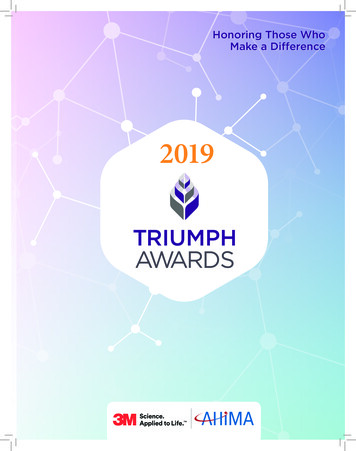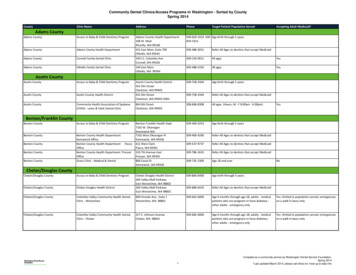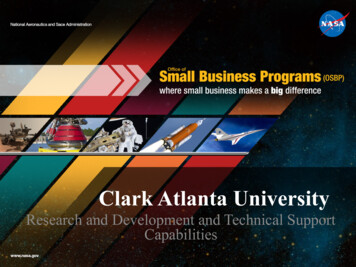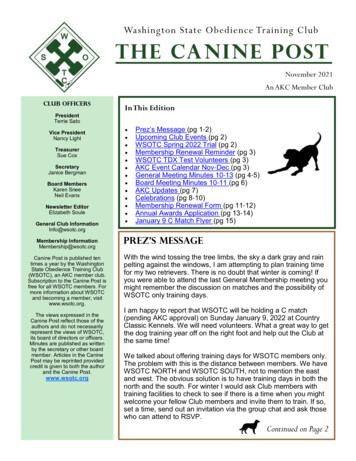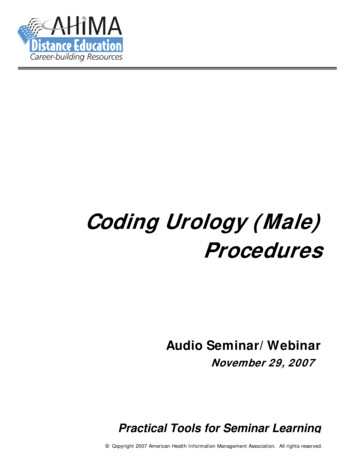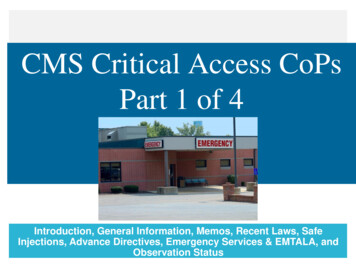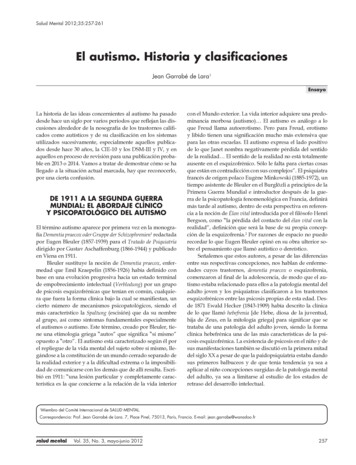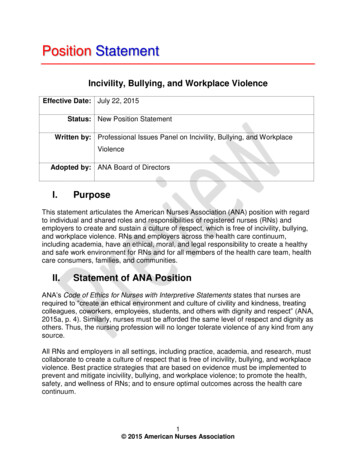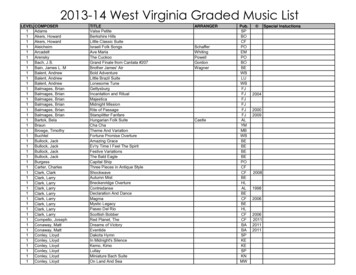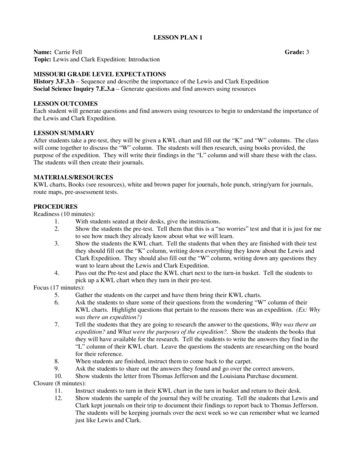
Transcription
The Joint Commission Mock Tracer Made Simple, 17th Edition Clark, ForbesJointCommissionMock TracerMade SimpleThe17th EditionJean S. Clark, RHIA, CSHAHeather Forbes, RN, BSN, CEN, CSHA, HACPThe Joint Commission Mock Tracer Made Simple, 17th Edition, is thenewest version of HCPro’s premier survey prep guide. This updated edition lets youthoroughly train your entire organization on the most up-to-date standards, ensuringeveryone is ready when surveyors walk through your front door.The book clearly and concisely breaks down standards in a mock survey checklistformat and shows you how to perform practice tracers throughout your organization.Use it to train chapter leaders and committee members so they can easily delegatethe right forms to the right people on their committees.Save yourself time and effort in preparing your organization—this toolkit does the prepwork for you!This training resource will help you: Identify and address compliance weak spots before surveyors find them Determine whether your facility and staff are ready for survey Train staff on their survey roles and responsibilities Use survey simulations and checklists to keep yourself organized and ensuremaximum readiness Save time with a handy collection of customizable lists and forms, distributable inprint or electronicallyJMT17100 Winners Circle, Suite 300Brentwood, TN 3702729533 MB323012 JMT17 Cover full.indd 117th EditionJointCommissionMock TracerMade SimpleTheJean S. Clark, RHIA, CSHAHeather Forbes, RN, BSN, CEN, CSHA, HACP7/8/15 11:22 AM
JointCommissionMock TracerMade SimpleThe17 T H E D I T I O NJean Clark, RHIA, CSHAHeather Forbes, RN, BSN, CEN, CSHA, HACP
The Joint Commission Mock Tracer Made Simple, Seventeenth Edition is published by HCPro, a division of BLRCopyright 2015 HCPro, a division of BLRAll rights reserved. Printed in the United States of America.5 4 3 2 1ISBN: 978-1-55645-726-5No part of this publication may be reproduced, in any form or by any means, without prior written consent of HCPro, orthe Copyright Clearance Center (978-750-8400). Please notify us immediately if you have received an unauthorized copy.HCPro provides information resources for the healthcare industry.HCPro is not affiliated in any way with The Joint Commission, which owns the JCAHO and Joint Commission trademarks.Jean S. Clark, RHIA, CSHA, AuthorHeather Forbes, RN, BSN, CEN, CSHA, HACP, AuthorJay Kumar, Associate Product ManagerRebecca Hendren, Product ManagerErin Callahan, Senior Director, ProductElizabeth Petersen, Vice PresidentMatt Sharpe, Production SupervisorVincent Skyers, Design Services DirectorVicki McMahan, Sr. Graphic DesignerMichael McCalip, Layout/Graphic DesignRJ Clarke, Cover DesignerAdvice given is general. Readers should consult professional counsel for specific legal, ethical, or clinical questions.Arrangements can be made for quantity discounts. For more information, contact:HCPro100 Winners Circle, Suite 300Brentwood, TN 37027Telephone: 800-650-6787 or 781-639-1872Fax: 800-785-9212 E-mail: customerservice@hcpro.comVisit HCPro online at: www.hcpro.com and www.hcmarketplace.com
ContentsAbout the Authors.ivPreface. vChapter 1: Understanding the Joint Commission Standards and Managing the Mock Survey Process. 1Chapter 2: Scoring Guidelines and Tracer Planning. 9Chapter 3: Pulling It All Together: Mock Surveys. 23Chapter 4: Patient Tracers. 33Chapter 5: System Tracers. 39Chapter 6: Tracer Tactics. 47ChecklistsPresurvey Checklist: Accreditation Participation Requirements. 85Checklist 1: National Patient Safety Goals. 93Checklist 2: Emergency Management (EM).107Checklist 3: Environment of Care (EC). 121Checklist 4: Human Resources (HR). 145Checklist 5: Performance Improvement (PI).155Checklist 6: Infection Control (IC). 161Checklist 7: Leadership (LD).173Checklist 8: Life Safety Code . 209Checklist 9: Information Management (IM). 235Checklist 10: Medical Staff (MS). 245Checklist 11: Medication Management (MM).275Checklist 12: Nursing (NR).301Online ChecklistsChecklist 13: Provision of Care, Treatment, and Services (PC)Checklist 14: Record of Care, Treatment, and Services (RC)Checklist 15: Rights and Responsibilities of the Individual (RI)Checklist 16: Transplant Safety (TS)Checklist 17: Waived Testing (WT)Checklist 18: Medical Staff Leaders’ ResponsibilitiesChecklist 19: Department Managers’ ResponsibilitiesChecklist 20: Patient Unit Interdisciplinary Teams’ ResponsibilitiesChecklist 21: Ambulatory Sites Including Physicians’ OfficesChecklist 22: The Patient Safety Systems (PS) ChapterChecklist 23: The Joint Commission’s Frequently Asked Questions (FAQ) 2015 HCProThe Joint Commission Mock Tracer Made Simple, 17th Edition n iii
About the AuthorsJean S. Clark, RHIA, CSHAJean S. Clark, RHIA, CSHA, has been a leader in the field of accreditation and regulatory compliance andhealth information management for more than 30 years. She graduated with honors from the Medical Universityof South Carolina School of Health Related Sciences. She served as the president of the American HealthInformation Management Association (AHIMA), the International Health Information ManagementAssociation, the Southeastern Medical Record Association, and two terms for the South Carolina HealthInformation Management Association (SCHIMA). She also received AHIMA’s Distinguished Member, Literary,and Volunteer awards and the Southeastern Medical Record Association and SCHIMA Distinguished Memberaward.She is a well-known speaker on accreditation and regulatory compliance. Currently, she teaches the HCProAccreditation Boot Camps, writes a column for Medical Records Briefing, and authors books on accreditationand regulatory compliance. She lives in Charleston, South Carolina.Heather Forbes, RN, BSN, CEN, CSHA, HACPHeather Forbes, RN, BSN, CEN, CSHA, HACP, is the clinical manager for Maine Medical PartnersNeurology, both the adult and pediatric neurological programs. In this role, she works closely with the MaineMedical Partners clinical staff and leadership teams, providing direction and oversight to clinical practice, clinical competency, and professional development programs. Forbes is also responsible for guiding, organizing, andimproving strategies to promote a constant state of organizational readiness with all accrediting, licensing, andregulatory bodies and, perhaps more importantly, to facilitate a culture of patient safety.She is a published author, speaker, and consultant for healthcare accreditation, including The Joint Commissionand the Centers for Medicare & Medicaid Services.iv n The Joint Commission Mock Tracer Made Simple, 17th Edition 2015 HCPro
PrefaceSince 2006, hospitals accredited by The Joint Commission have been subject to the unannouncedsurvey. Approximately 15,000 healthcare organizations in the United States are striving to achieveand maintain accreditation, and among them, The Joint Commission seems to be the primary regulator. Some organizations have moved to other accrediting bodies, such as Det Norske Veritas(DNV), the American Osteopathic Association’s Healthcare Facilities Accreditation Program(HFAP), the Association for Ambulatory Healthcare (AAAHC), and the Center for Improvementfor Healthcare Quality (CIHQ). Regardless of the accrediting agency, hospitals and healthcareorganizations need to have a process in place to ensure compliance with the standards and withthe Centers for Medicare & Medicaid Services (CMS) Conditions of Participation (CoP). The tracer methodology introduced by The Joint Commission has proven to be a useful tool to assess boththe patient care process and other supportive processes within a hospital. It can help to identifygaps in compliance and knowledge deficits, as well as exemplary practices.Continuous survey readiness—including a mock survey approach that fully integrates the tracer methodology—is a good way to take a snapshot of the organization’s compliance and to help staff maintain a level of comfort when an unannounced survey does occur. This approach can also supplementyour overall quality program by helping you identify items to improve in order to maintain the stateof readiness.This book outlines an organized, systematic approach to monitoring compliance on a continuousbasis. It offers tools t h at you can use to conduct tracers throughout the year. I f yo u i n t e g r at ethe activities described into the operations and infrastructure of the organization’s quality process, itwill become less of a compliance assessment activity and more of a quality assessment, monitoring,and improvement activity.We have designed an approach to support continuous readiness using recent editions of HCPro’s The JointCommission Mock Tracer Made Simple. Available for download are the Joint Commission chapter checklists with completely updated content. You can access them at www.hcpro.com/downloads/12440, alongwith the focused tracer tools highlighted in the book. On the downloadable files, you’ll see icons next tomost chapter checklist items that can help you quickly assess each standard’s relative importance. Here isa key explaining what each symbol means.Symbols in This BookLimited Scope icon: If you need to limit the scope of your mock survey, first gauge compliance with all ofthe assessment points marked with this icon. Surveyors will likely scrutinize these issues the most. After youhave completed this initial high-priority assessment, if you find that you can expand the scope, go back and 2015 HCProThe Joint Commission Mock Tracer Made Simple, 17th Edition n v
Prefaceassess compliance with the remaining standards. This way, your teams can begin correcting problems that arehighly likely to affect the survey before addressing minor compliance issues.Hot Topic icon: This indicates the items that have presented the greatest challenge.P Policy icon: This indicates standards that require a policy.D Documentation icon: This indicates standards that require documentation.New/Changed Standard icon: This indicates revisions or additions by The Joint Commission for thisyear.The book is designed to offer sound advice and practical examples on conducting tracers that resultin a move to establish continuous compliance. For this process to be effective, mock tracers must bepart of a living, fluid, working process. Each tracer is a “snapshot” in time that can reveal areas forimprovement as well as areas of exemplary practice. To be continuously compliant or at least continuously aware of their compliance status, hospitals must regularly measure and monitor compliance.The Joint Commission Mock Tracer Made Simple is a toolkit that will help you on your road tocontinuous compliance. Do you know at any given time what the compliance issues are in yourorganization? The goal is to know the organization inside and out so that when the actual surveyoccurs, there are no surprises. Integrating a self-assessment, mock survey process, and tracer methodology activities into daily operations allows you to identify deficiencies and build action plansthat will lead to sustained compliance.How This Book Is OrganizedChapter 1 provides an overview of the Joint Commission standards and survey process as well asthe critical link to the CMS CoP. Also covered are suggestions for managing the mock surveyprocess and evaluating the results.Chapter 2 includes a detailed explanation of how the scoring works and how to think about theimpact of the scoring when conducting a mock survey with integrated tracers. In addition, this chapter offers insight into integrating the tracer methodology into daily operations. Guidance is given onmaintaining an organized approach, getting the right people involved, keeping the momentum going,communicating important informastion identified in the tracer process, and measuring and monitoringany plans for improvement you may put into place. It will answer questions such as: When to begin? Who should conduct the tracers? What tracers should you conduct and where do you start?vi n The Joint Commission Mock Tracer Made Simple, 17th Edition 2015 HCPro
Preface What to report and how to monitor compliance?Chapter 3 provides a review of a comprehensive mock survey as well as a limited-scope mock survey process. Readers will be able to download succinct examples of compliance checklists for eachfunctional chapter assessment point, drawn directly from experiences in real hospital settings. Asyou review the checklists, keep in mind that they include only examples of compliance, and arenot the only way to comply.Chapter 4 describes the patient tracer. The focus of this chapter is on the provision of patient carewithin your hospital. An essential read for the tracer team, it will allow the tracer team to see thepoints of care to validate the presence or absence of interdisciplinary care, critical communicationbetween and among caregivers, and continuity and collaboration across the organization. Included inthis chapter are sample patient tracer tools.Chapter 5 describes the system tracer. This tracer process can be applied to any area of the hospital,not just direct patient care. The focus should be on high-risk, problem-prone, and high- or low-volume system processes. Once again, it will allow the tracer team to see the points of the system orprocess from beginning to end and validate the presence or absence of the appropriate steps.Chapter 6 includes tracer tools and actual case studies: General Patient Care Tracer Tool Infection Control Tracer Tool Medication Management Tracer Tool Tissue Tracer Tool Patient Safety Tracer Tool Physical Environment Tracer Tool Equipment Use Tracer Tool 2015 HCProThe Joint Commission Mock Tracer Made Simple, 17th Edition n vii
CHAPTER 1Understanding the Joint CommissionStandards and Managing the Mock SurveyProcessThe evolution of The Joint Commission’s accreditation process continues. In January 2013, the accreditor introduced the Intracycle Monitoring (ICM) Profile to help accredited organizations with their ongoing complianceefforts at “touch points” throughout the triennial cycle. ICM provides hospitals with access to a robust workspace through their secure extranet site (EApp) that, through information, tools, resources, and solutions, allowshospitals to assess accreditation information continuously.Another significant development is that the Periodic Performance Review (PPR) tool has been replaced with theFocused Standards Assessment (FSA) tool. Through its own risk assessment, The Joint Commission has identified target elements of performance (EP) that pose higher risk and that need to be included in the FSA. Theseselect EPs are identified with an “R” icon to indicate their critical impact on patient care and safety. At a minimum, an organization must score the “R” standards, but it can also supplement the FSA with EPs that it hasindependently determined to be high risk. Doing so can make the FSA a very tailored and organization-specificexercise that provides building blocks for tracer reviews.The Joint Commission has added a new chapter, Patient Safety Systems, to its ComprehensiveAccreditation Manual for Hospitals, and it has also added a new National Patient Safety Goal (NPSG)that focuses on management of clinical alarms. This book includes information and checklists that relateto these new additions as well as to anticipated changes to diagnostic imaging services.For many organizations, the tracer methodology has become one of the primary tools for assessing compliance.During survey, organizations can expect to see the tracer methodology applied to patient care as well as to anyand all processes that relate to or support it. Make sure that you prepare staff for a fluid, interactive survey process—one in which any member of the healthcare team may be asked to participate. Survey coordinators shouldhave full knowledge of their organization’s compliance status. An organized and ongoing compliance assessmentprocess with tracers integrated throughout the triennial cycle is an excellent way to stay prepared. The goal forsurvey should be “no surprises.” 2015 HCProThe Joint Commission Mock Tracer Made Simple, 17th Edition n 1
Chapter 1Core Survey ProcessFollowing are the core aspects of the survey process. Note that The Joint Commission has eliminated the use ofClinical Service Groups (CSG) and Priority Focus Areas (PFA) to determine the focus for on-site surveys.Instead, surveyors will focus on information from the organization’s ICM, FSA, and Requirements forImprovement (RFI) from the previous survey. Three standard areas have been selected as system tracers andapplied to every organization: Medication Management, Infection Control, and Data Use. The second-generation tracers discussed later in this chapter continue to be part of the on-site survey.Tracer methodologyIn industry, a tracer involves following a product from start to finish to identify process and system issues. Inhealthcare, the tracer is the patient or a particular system. Using the outputs from the ICM as a reference, surveyors will request daily census lists, operating room schedules, procedure schedules, and other data sources toselect patients to trace. Patients selected as tracers much meet the following criteria: They have received complex services and usually are close to discharge They crossed different programs (e.g., emergency department to intensive care unit to med/surg, or acuteto long-term care) They are related to system tracersThe survey team will review the record selected, taking note of key actions, and then visit the other units/departments where care was delivered or services were rendered and interview staff members about the processes involved. If the hospital being surveyed still uses paper medical records, the surveyor will not remove themedical record from the unit where the patient is located but instead will work from his or her notes taken during the tracer. For hospitals that have moved to an electronic health record (EHR) system, the record can usuallybe referred to at any place in the hospital. However, it is always used at the point of care, as the surveyor interviews the nurse or other caregiver who is assigned to the patient being traced. Whether using paper records orEHR, staff being interviewed by surveyors must be able to locate information quickly in the medical record.Tracers can help to hone this process and build staff confidence.During an average three-day survey, it is expected that the survey team will be able to complete nine to 12 tracers. On average, a tracer will take 90 minutes, but in actual surveys, they can take up to three hours, and theyshould take 60%–70% of the survey time. The tracer process is expected to include the following: Observation of care delivery Interviews Medical record reviews Environment of care observations2 n The Joint Commission Mock Tracer Made Simple, 17th Edition 2015 HCPro
Understanding the Joint Commission Standards and Managing the Mock Survey Process Infection prevention Privacy and confidentiality of medical records as well as patients Observation of medication-related processes—ordering, safety, and security Observation of care planning Patient or family interview Staff competency Review of additional medical records as indicated (e.g., requests for closed records for restraints if nopatients are on restraints during the on-site survey)In addition, a surveyor may interview staff members about performance improvement and patient safety activities, their daily duties and clinical practice, and their orientation and training. Review of policies and proceduresmay also occur as indicated by discussions or questions raised by a surveyor.As the surveyors interview staff members about care processes and other systems, they will try to speak to theactual staff members involved with the patient, but if those staff are not available, they will speak to others inthe same role. The patient or the family also will be interviewed whenever possible. Surveyors now spend a significant amount of time observing actual care by watching medication passes, observing dressing changes, visiting operating room suites to verify timeout and medication labeling requirements, and even observing deliveries.Chapter 3 describes the patient tracer process in more detail and provides examples of actual case studies.The system tracers remain the same as they were before and include Data Use, Infection Prevention, andMedication Management. The surveyors seem to have quite a bit of latitude in conducting system tracers; somehold a meeting with an interdisciplinary group (which is pretty standard for Data Use and Infection Prevention),while some go to the unit and trace a patient who has an infection or is receiving high-risk medication, interviewing multiple members of the care team about their areas of focus in a patient of this type. Regardless of theformat, the system tracers are scheduled activities. Chapter 4 provides a more detailed description of systemtracers with examples of their application.Second-generation tracers have now been added to the tracer mix. These focus on specific topics that may warrant closer observation (i.e., digging deeper) as a result of patient tracers. Second-generation tracers include thefollowing: Cleaning, disinfection, and sterilization Contract services Ongoing and focused professional practice evaluation (OPPE and FPPE) Diagnostic imaging Therapeutic radiation 2015 HCProThe Joint Commission Mock Tracer Made Simple, 17th Edition n 3
Chapter 1 Patient flow across the continuum Clinical/health informationThere are several triggers that can lead to a second-generation tracer: patterns of practice, inconsistent application of processes across the hospital system, trends in unsafe patient care, or safety issues. Hospitals should beparticularly aware of these areas and ensure that they are in compliance to avoid increased surveyor scrutiny.Using the tracer methodology, surveyors will look for compliance with standards and patient safety goals, compliance with internal policies, consistent responses, collaboration across disciplines, communication of allimportant information, and competence of staff members. During their interactions with staff, surveyors willcollect names and review their competence and credentials later in the survey.Program-specific tracersDesigned to focus on important processes, these tracers concentrate on specific topics such as laboratory integration, suicide prevention, and emergency management. Surveyors will integrate these topics when performingpatient tracers.Scheduled interdisciplinary conferencesYour survey schedule is provided to you on your secure extranet site. Be aware that the survey team can changethe schedule while on-site; the hospital can also request changes to the agenda. The survey coordinator and theJoint Commission team leader usually discuss such changes on the first morning of the survey.In general, there are relatively few scheduled interdisciplinary conferences. Surveyors now begin the unannounced survey with a planning session to give the organization time to gather its leaders for the opening conference/introduction that will follow. Following that planning session is the opening conference, which involvesthe leadership, competency assessment, medical staff credentialing, environment of care, emergency management, and system tracers. The survey team also holds a second, formal conference with leadership late in thesurvey to explore issues identified during the survey and to discuss compliance with leadership standards.The competency and credentialing conferences are scheduled well into the survey so that they can include documentation on individuals encountered during the surveyors’ rounds. Some surveyors conduct these conferencesin two parts: The first part focuses on review of documentation, while the second focuses on broader issues andeducation.Tips for readinessThe following are some general tips for readiness regarding various aspects of a survey: Documents for review: The list of documents that must be available includes items that can be gatheredin advance as well as items that will need to be pulled the morning of the survey. The documents list islocated in The Joint Commission’s survey activity guide; review this list in advance. Many organizationskeep a binder ready to go in the event of an unannounced survey. Conduct a practice run to ensure that4 n The Joint Commission Mock Tracer Made Simple, 17th Edition 2015 HCPro
Understanding the Joint Commission Standards and Managing the Mock Survey Processdocuments that need to be located on the morning of the survey (e.g., lists of patients, procedures, surgeries, ambulatory/diagnostic testing appointments, etc.) can be retrieved quickly and efficiently. There isalso a list of items that may be requested when the surveyor identifies an issue. Ensure that these itemsare current and accessible. Closed medical record review session: There is no scheduled closed medical record review; the focus willbe on current, open records. If questions about compliance with documentation in the record arise, or ifthere are no patients of a certain type in the hospital at the time of the survey, the surveyors may ask fora sample of closed records to review. For example, if there are no patients in restraints at survey time,the surveyors will ask for a sample of closed records involving patients in restraints. Also, the medicalrecord delinquency form must be completed and ready for the survey team. Don’t lose sight of yourdelinquency rate; it can affect your accreditation status if it exceeds twice the average monthly discharges. Leadership conferences: Following the surveyor planning session, the surveyors have their first meetingwith the leaders during the opening conference,. This conference sets the stage by helping surveyorsunderstand what the organization is all about and what they should expect to find during the remainderof the survey. The Joint Commission says that a formal presentation is not required for this session;however, most hospitals prepare a short PowerPoint presentation and obtain approval from the JointCommission team leader to present it at the opening conference. Some organizations have also found ithelpful to put together an overview as a handout for the survey team. This handout can be used as a reference throughout the survey, and it gets your leadership team to think about possible survey focusissues. Usually scheduled on the last day, the formal leadership conference focuses on issues identifiedduring survey and is led by the team leader, with input from the survey team. It provides a chance forleadership to respond to compliance issues and to demonstrate knowledge of The Joint Commission’sleadership requirements. In recent surveys, this conference has focused on leaders’ concept of their progress toward creating a highly reliable organization. Surveyors have emphasized several articles on thistopic written by Joint Commission President Mark Chassin, MD, FACP, MPP, MPH. Ensure that a leader is familiar with these articles and is prepared to speak to them at the leadership conference. Also beprepared to discuss the new Patient Safety Systems (PS) chapter. A checklist for this chapter, as well asfor the clinical alarm management National Patient Safety Goal, has been added to the Checklists section of this book. Competency assessment processes: The surveyors will identify times toward the end of the survey toreview documentation of employees’ competency and the credentials of staff members with privileges.Expect names of staff members who interacted with surveyors during tracers to make up the bulk ofthis review. Also expect surveyors to request specific compe
The Joint Commission Mock Tracer Made Simple 17th Edition 100 Winners Circle, Suite 300 Brentwood, TN 37027 JMT17 The Joint Commission Mock Tracer Made Simple, 17th Edition, is the newest version of HCPro's premier survey prep guide. This updated edition lets you thoroughly train your entire organization on the most up-to-date standards, ensuring

